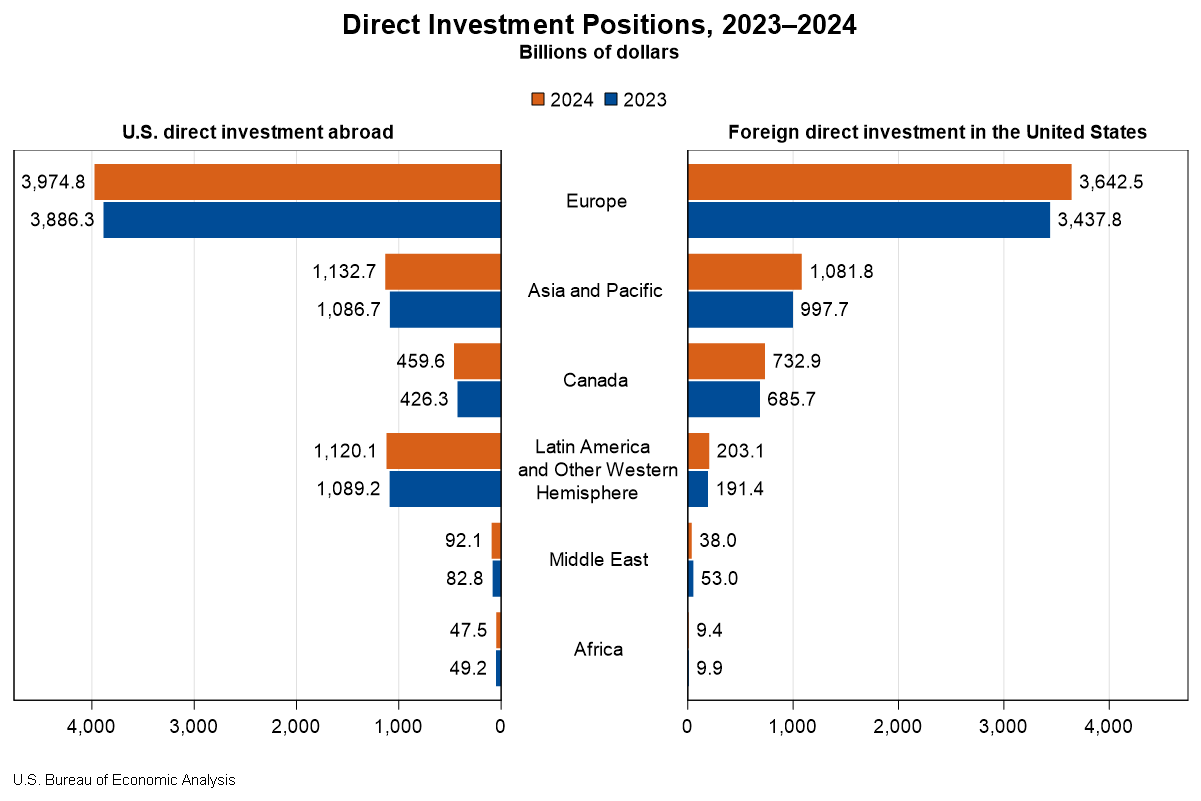Bureau of Economic Analysis
Direct Investment by Country and Industry, 2024
The U.S. direct investment abroad position, or cumulative level of investment, increased $206.3 billion to $6.83 trillion at the end of 2024, according to statistics released today by the U.S. Bureau of Economic Analysis. The increase was led by an $88.4 billion increase in the position in Europe, primarily in Luxembourg and Germany. By industry, manufacturing affiliates had the largest increase, led by manufacturing of computers and electronic products.
The foreign direct investment in the United States position increased $332.1 billion to $5.71 trillion at the end of 2024. The increase was led by a $204.7 billion increase in the position from Europe, which reflected a $52.9 billion increase from the United Kingdom and a $39.7 billion increase from Germany. By industry, affiliates in manufacturing increased the most.
Principal Federal Economic Indicators
Noteworthy
- 2025 News Release Schedule
- Innovation at BEA
- 2025 Annual Updates
- New! Services Trade Data for More Countries
- Data Tool: Trade in Value Added
- Distribution of State Personal Income
- Updated: RIMS II Regional Multipliers
- Arts and Culture
- Space Economy
- FDI Now in State BEARFACTS
- Quick Guide: Price Indexes
The Latest
State Quarterly Personal Income, 1st quarter 2009-3rd quarter 2010
WASHINGTON DC, December 17, 2010 - State personal income growth slowed to an average 0.7 percent in the third quarter of 2010 down from 1.4 percent in the second quarter, according to estimates released today by the U.S. Bureau of Economic Analysis. The slowdown was spread widely across the country with growth decelerating in 41 states, unchanged in 3, and accelerating in 6 states. The national price index for personal consumption…
U.S. International Transactions, 3rd quarter 2010
NOTE: See the navigation bar at the right side of the news release text for links to data tables, contact personnel and their telephone numbers, and supplementary materials.
Sarah Scott Thomas: (202) 606-9286
Revised Gross Domestic Product by Industry, 2009
Revised Statistics of Gross Domestic Product by Industry for 2007-2009
Downturns in durable-goods manufacturing and professional, scientific, and technical services along with the continued contraction of construction were among the leading contributors to the decline in U.S. economic growth in 2009, according to revised statistics on the breakout of real gross domestic product (GDP) by industry from the Bureau of Economic Analysis.
Personal Income and Outlays, October 2010
Personal income increased $57.6 billion, or 0.5 percent, and disposable personal income (DPI) increased $48.3 billion, or 0.4 percent, inOctober, according to the Bureau of Economic Analysis. Personal consumption expenditures (PCE) increased $44.0 billion, or 0.4 percent.
Gross Domestic Product, 3rd quarter 2010 (second estimate) | Corporate Profits, 3rd quarter 2010 (preliminary estimate)
Real gross domestic product -- the output of goods and services produced by labor and property located in the United States -- increased at an annual rate of 2.5 percent in the third quarter of 2010, (that is, from the second quarter to the third quarter), according to the "second" estimate released by the Bureau of Economic Analysis. In the second quarter, real GDP increased 1.7 percent. The GDP estimates released today are based on…
Gross Domestic Product by State, Advance 2009 and Revised 1963-2008
EMBARGOED UNTIL RELEASE AT 8:30 A.M. EST, THURSDAY, NOVEMBER 18, 2010
Personal Income and Outlays, September 2010
Personal income decreased $16.8 billion, or 0.1 percent, and disposable personal income (DPI) decreased $20.3 billion, or 0.2 percent, inSeptember, according to the Bureau of Economic Analysis. Personal consumption expenditures (PCE) increased $17.3 billion, or 0.2 percent.
Gross Domestic Product, 3rd quarter 2010 (advance estimate)
Real gross domestic product -- the output of goods and services produced by labor and property located in the United States -- increased at an annual rate of 2.0 percent in the third quarter of 2010, (that is, from the second quarter to the third quarter), according to the "advance" estimate released by the Bureau of Economic Analysis.




